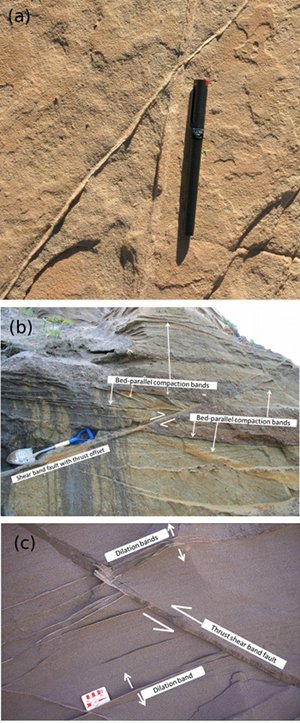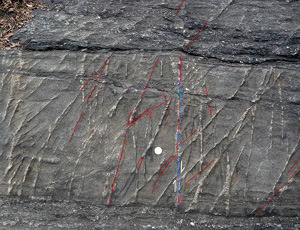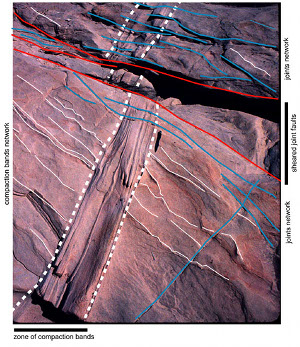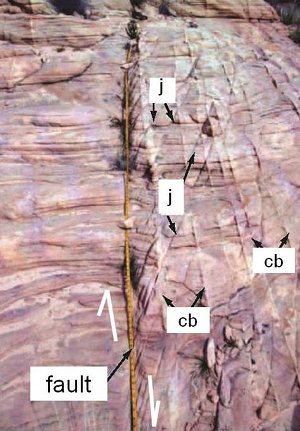| |||||||
|
|
|||||||
|
|
|||||||
| Assemblages of Deformation Bands, Joints, and Faults | |||||||
|
Figure 1a shows a simple case in which a shear band fault cuts and offsets a high-angle compaction band in sandstone. It is simple because both compaction band and shear band formed by strain localization into narrow bands albeit in different kinematics and at different times. Figure 1b shows a case which includes a shear band fault with a thrust sense of offset and a series of associated compaction bands in splay orientation. The compaction bands formed along bedding and this orientation is self consistent with the thrusting. Additional examples for this type of assemblages can be found in Mollema and Antonellimni (1996), and Du Bernard et al. (2002). One can easily imagine that once rocks with deformation bands are deformed by jointing which is quite common in the field, the joints would provide weak planes to accommodate later shearing. The first example of this situation is from New York's Grand Central Park that we used for compaction bands and joint assemblages. Figure 2 shows two major sets of what appear to be compaction bands overprinted by two sets of joints and one fairly noticeable fault. Figure 3 shows a compaction band zone (thick white dashed lines) and two sets of related compaction band networks (thin solid white lines) overprinted by two sets of joints (blue) and a fault of about 25 cm left-lateral sense of apparent offset. It is reasonable to assume that similar to the case in Figure 2, a more prominent joint zone was later sheared to form the fault. Another example for this case is shown in Figure 4 in which a sheared joint fault overprinted one member of a compaction band set (measuring tape was placed on top of the compaction band-sheared joint pair). An interesting outcome of this juxtaposition is that a series of these splay joints associated with the shearing of the bounding first generation joint cuts across other members of the compaction band set at an oblique angle. | |||||||
| Reference: |
|||||||
| Du Bernard, X., Eichhubl, P., Aydin, A., 2002 Mollema, P., Antonellini, M., 1996 Tondi, E., Antonellini, M., Aydin, A., Marchegiani, L., Cello, G., 2006 Zhou, X., Karimi-Fard, M., Durlofsky, L.J., Aydin, A., 2012 |
|||||||
|
Readme | About Us | Acknowledgement | How to Cite | Terms of Use | Ⓒ Rock Fracture Knowledgebase |
|||||||



